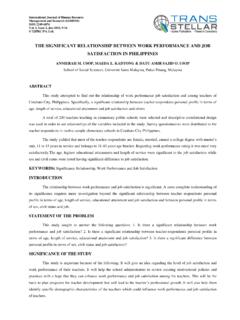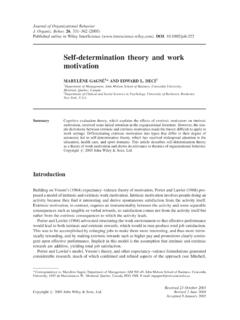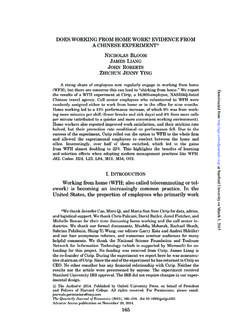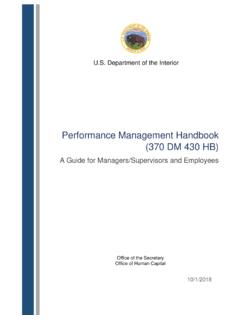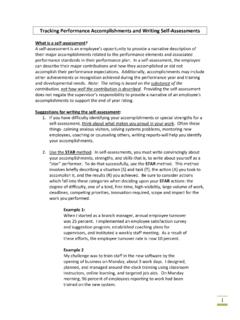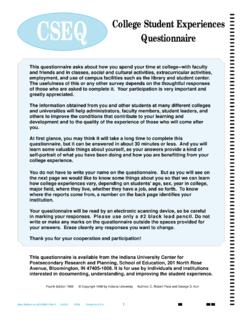Transcription of The Job Satisfaction-Job Performance Relationship: A ...
1 Psychological Bulletin Copyright 2(X)1 by the American Psychological Association, Inc. 2001, Vol. 127. No. 3. 376-407 (XB3-2909/01 DOI: The Job Satisfaction-Job Performance Relationship: A Qualitative and Quantitative Review Timothy A. Judge Carl J. Thoresen University of Iowa Tulane University Joyce E. Bono Gregory K. Patton University of Iowa University of North Dakota A qualitative and quantitative review of the relationship between job satisfaction and job Performance is provided. The qualitative review is organized around 7 models that characterize past research on the relationship between job satisfaction and job Performance . Although some models have received more support than have others, research has not provided conclusive confirmation or disconfirmation of any model, partly because of a lack of assimilation and integration in the literature.)
2 Research devoted to testing these models waned following 2 meta-analyses of the job Satisfaction-Job Performance relation- ship. Because of limitations in these prior analyses and the misinterpretation of their findings, a new meta-analysis was conducted on 312 samples with a combined N of The mean true correlation between overall job satisfaction and job Performance was estimated to be .30. In light of these results and the qualitative review, an agenda for future research on the satisfaction - Performance relationship is provided. The study of the relationship between job satisfaction and job have arisen, we provide both a qualitative and a quantitative Performance is one of the most venerable research traditions in review of the literature.
3 Thus, the article is organized into three industrial-organizational psychology. This relationship has been major sections. First, we qualitatively review past research on the described as the "Holy Grail" of industrial psychologists (Landy, job Satisfaction-Job Performance relationship. In this section, we 1989). Indeed, interest in the link between workplace attitudes and briefly summarize previous reviews of the literature and then productivity goes back at least as far as the Hawthorne studies consider various conceptualizations of the satisfaction -perfor- (Roethlisberger & Dickson, 1939), and the topic continues to be mance relationship. Second, we report on the results of a meta- written about to this day.
4 Although the area has not lacked for analysis that remedies limitations in past meta-analytic reviews qualitative (Brayfield & Crockett, 1955; Herzberg, Mausner, and provides the most comprehensive evidence to date on the Peterson, & Capwell, 1957; Locke, 1970; Schwab & Cummings, magnitude of the relationship between job satisfaction and job 1970) or quantitative (laffaldano & Muchinsky, 1985; Petty, Mc- Performance . Finally, in light of our qualitative and quantitative Gee, & Cavender, 1984) reviews, these reviews deserve some reviews, we provide suggestions for future research that could scrutiny. Moreover, there have been many developments in the further understanding of the nature of the satisfaction - Performance past several years that merit renewed discussion and integration of relationship.
5 This literature. Accordingly, the purpose of the present article is to reexamine Past Research on the job satisfaction - the state of the literature concerning the relationship between job Job Performance Relationship satisfaction and job Performance . Given the breadth and complex- ity of the literature, as well as the nature of some of the issues that The potential linkage between employee attitudes and perfor- mance was considered in earnest in the 1930s, coinciding with (and as a result of) the Hawthorne studies and the ensuing human relations movement. Although the Hawthorne studies are com- Timothy A. Judge and Joyce E. Bono, Department of Management and monly credited with emphasizing a linkage between employee Organizations, University of Iowa; Carl J.
6 Thoresen. Department of Psy- attitudes and Performance , researchers were more circumspect in chology, Tulane University; Gregory K. Patton, Management Department. their conclusions than most assume ( , Roethlisberger, 1941). It University of North Dakota. is clear, however, that the human relations movement stimulated Joyce E. Bono is now at the Department of Psychology, University of Minnesota. interest in the relationship. Following the human relations move- We thank Frank L. Schmidt for his comments that inspired this study. ment, the most influential narrative review of the job satisfaction - Correspondence concerning this article should be addressed to Timothy job Performance relationship was published by Brayfield and A.
7 Judge, who is now at the Department of Management, Warrington Crockett (1955). In this article, the authors reviewed studies relat- College of Business, University of Florida. Gainesville, Florida 32611. ing job satisfaction to job Performance as well as to a number of Electronic mail may be sent to other behavioral outcomes (accidents, absence, and turnover). 376. job satisfaction AND JOB Performance 377. Brayfield and Crockett concluded that there was not much of a Job Performance Model 1 job satisfaction relationship between job satisfaction and Performance , labeling it as "minimal or no relationship" (p. 405). The Brayfield and Crock- ett review was limited by the very small number of published studies available for review at that time (only nine studies were reviewed that reported a correlation between individual job satis- faction and job Performance ) and the general subjectivity of qual- Model 2 job satisfaction Job Performance itative reviews.
8 In spite of these shortcomings, Brayfield and Crockett's article was perhaps the most frequently cited review in this area of research prior to 1985. Since the Brayfield and Crockett (1955) review, several other influential narrative reviews have been published (Herzberg et al., 1957; Locke, 1970; Schwab & Cummings, 1970; Vroom, 1964). Model 3 job satisfaction > Job Performance These reviews differed greatly in their orientation and, to some degree, in the optimism they expressed regarding the satisfaction - Performance relationship, with Herzberg et al. being the most optimistic. The main gist of two of these reviews (Locke, 1970;. Schwab & Cummings, 1970) was to issue a strong call for theory- Model 4.
9 Driven investigations of the satisfaction - Performance relationship. In response to these reviews, researchers began to consider more closely the nature of the relationship, giving particular consider- ation to factors that might moderate or mediate the relationship. Accordingly, in the next section of the article, we group these Model 5. investigations into seven models of the satisfaction - Performance relationship and review research that has been conducted on these functional forms. Nature of the job satisfaction - Model 6. Job Performance Relationship There are at least seven different ways in which the satisfaction - Performance relationship has been specified. A graphical depiction of the different functional forms is provided in Figure 1.
10 These theoretical perspectives previously have not been reviewed to- Model 7 job satisfaction Job Performance gether; accordingly, below we provide a review of each of these perspectives. Before each of these models is discussed, however, a brief discussion of the typical means through which studies inves- Affect Performance tigating the satisfaction - Performance relationship have been con- ducted is warranted. By far, the most dominant methodology has Figure 1. Models of the relationship between job satisfaction and job involved the concurrent investigation of these two variables. Performance . (Note that in Models 4 and 5, C denotes a third variable.). (However, as we note in discussing Model 6, the correlation between satisfaction and Performance is not the focus of the vast majority of studies that have shown a correlation between the logical grounds) any unmeasured variables that could spuriously constructs.
